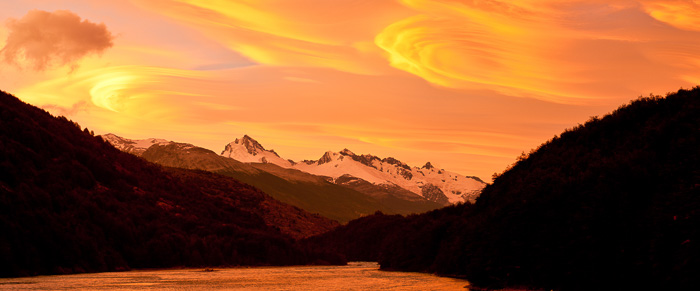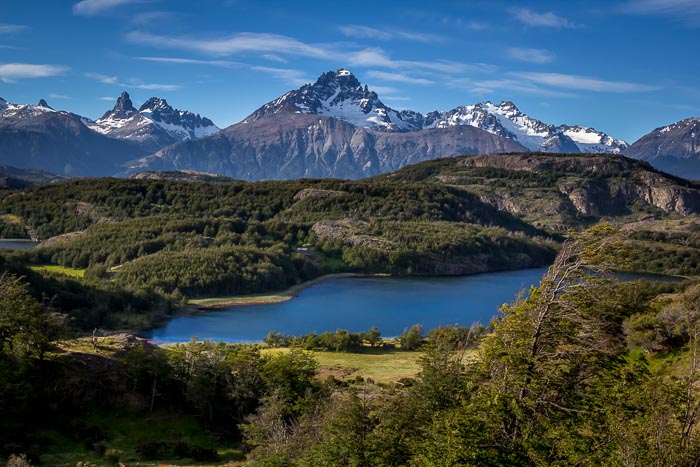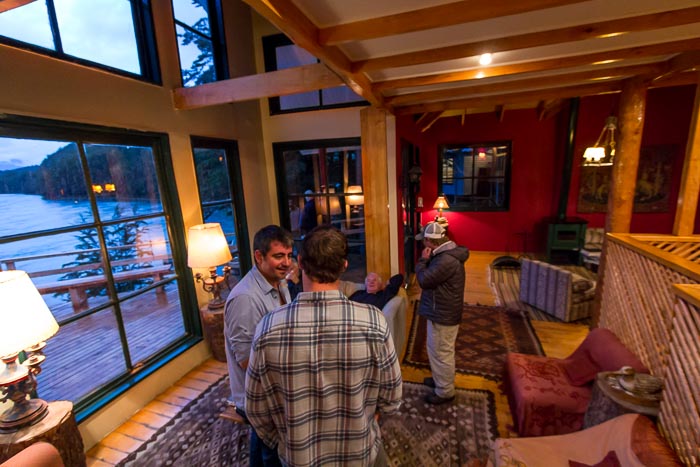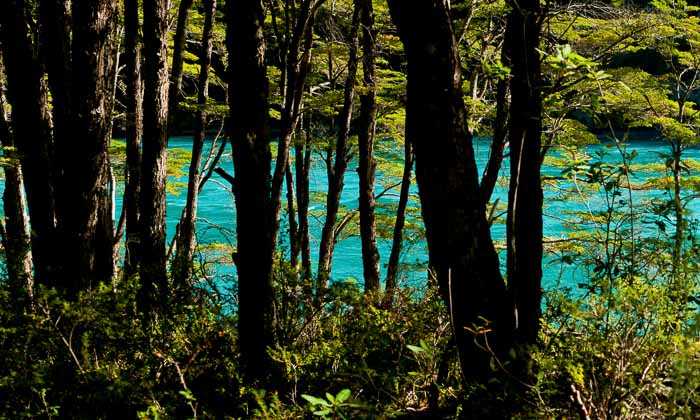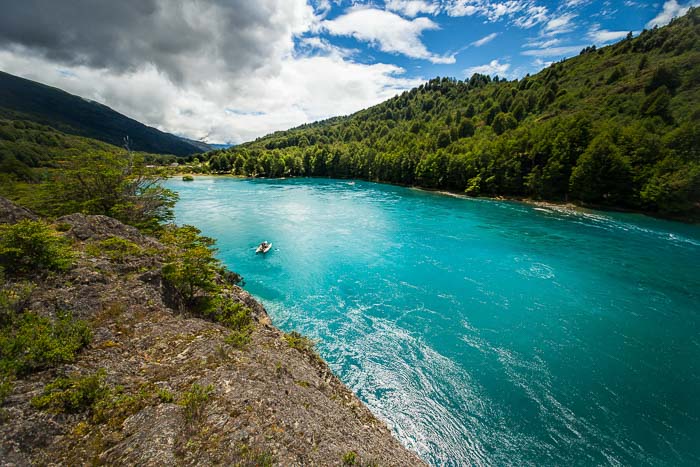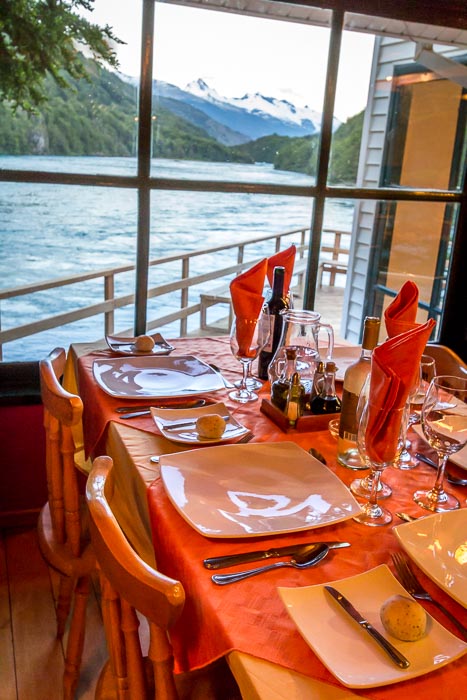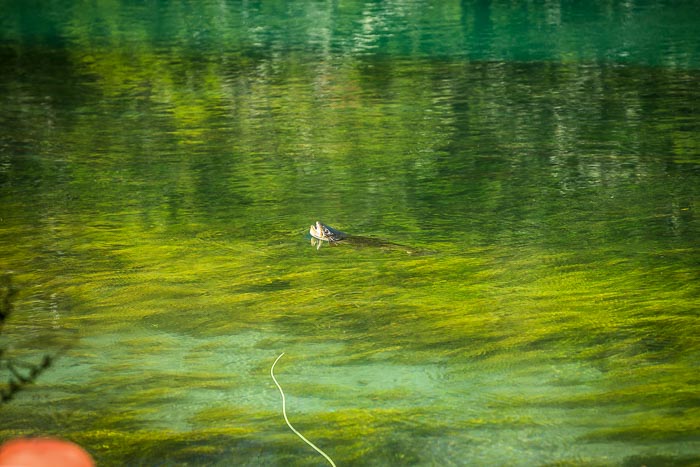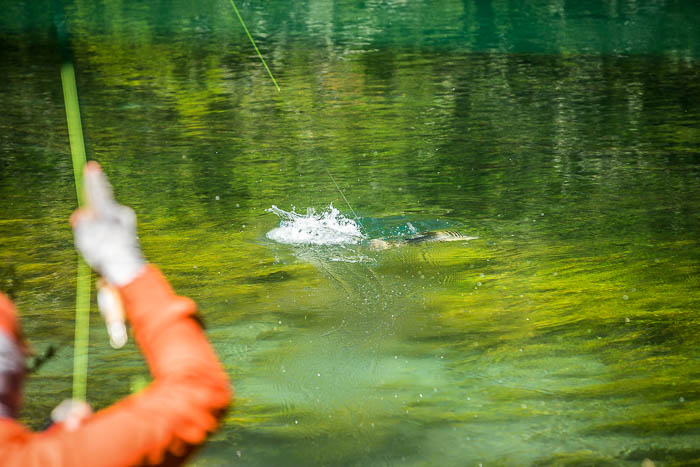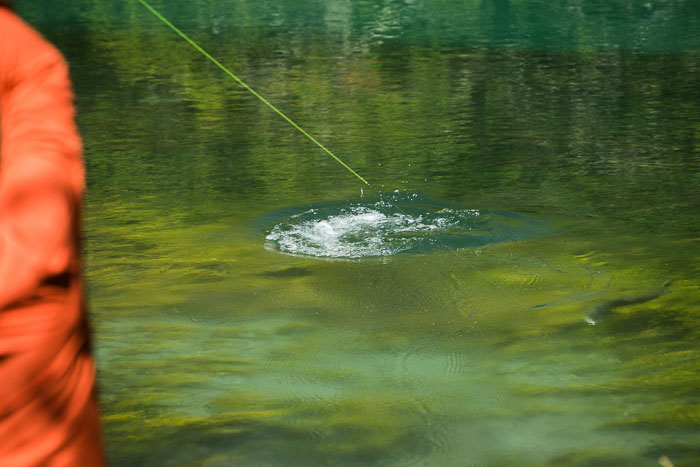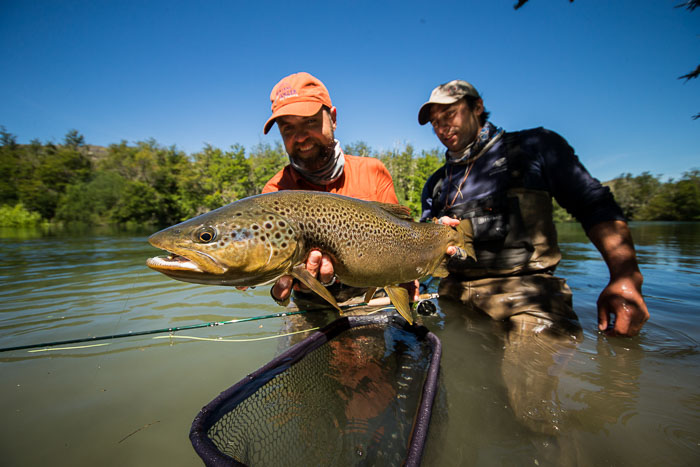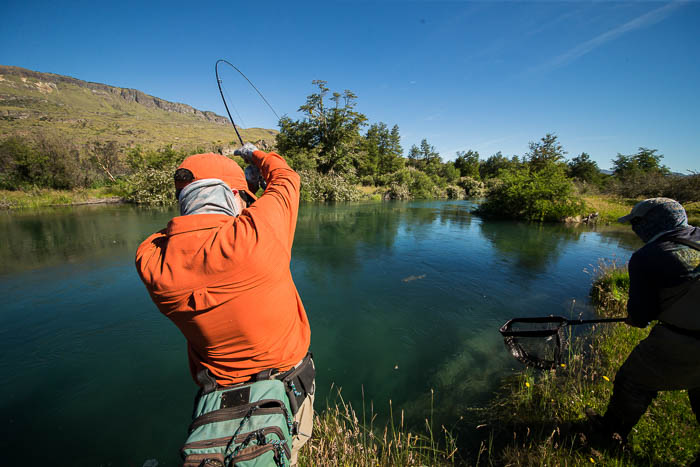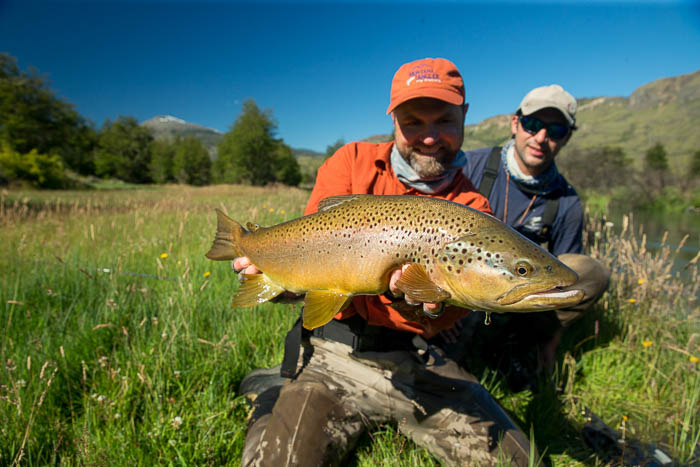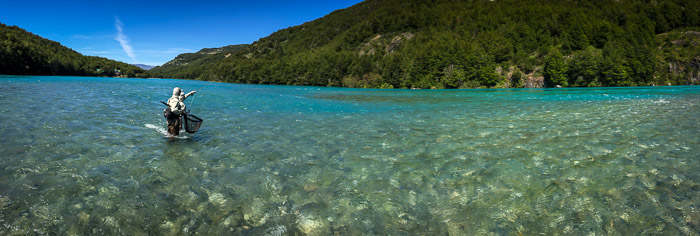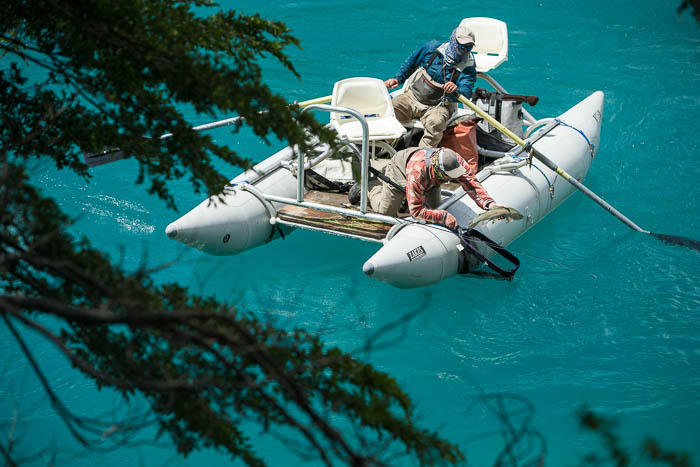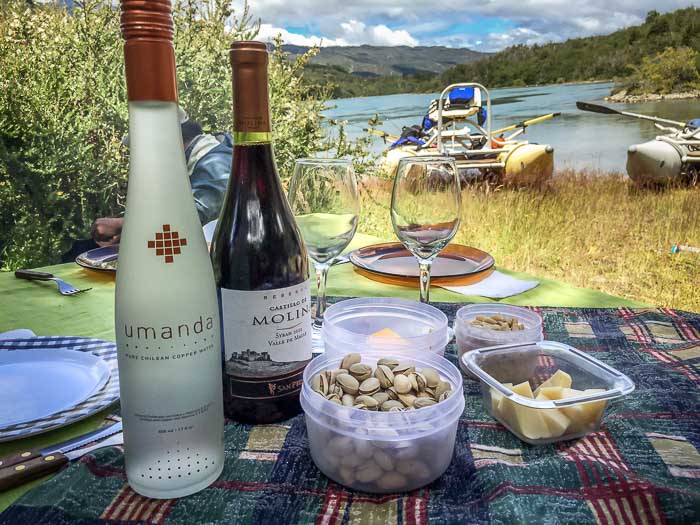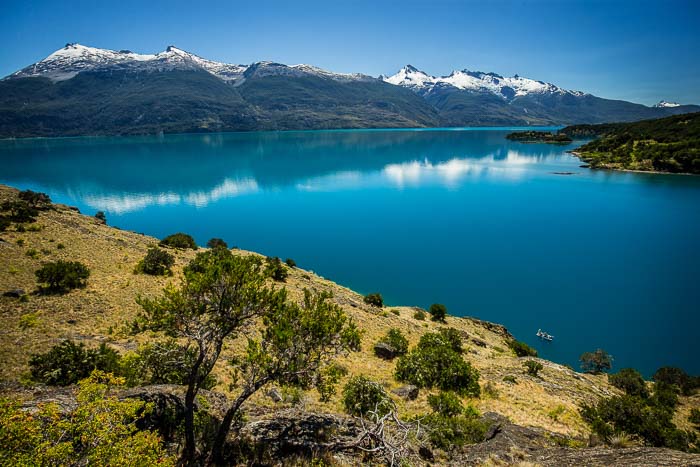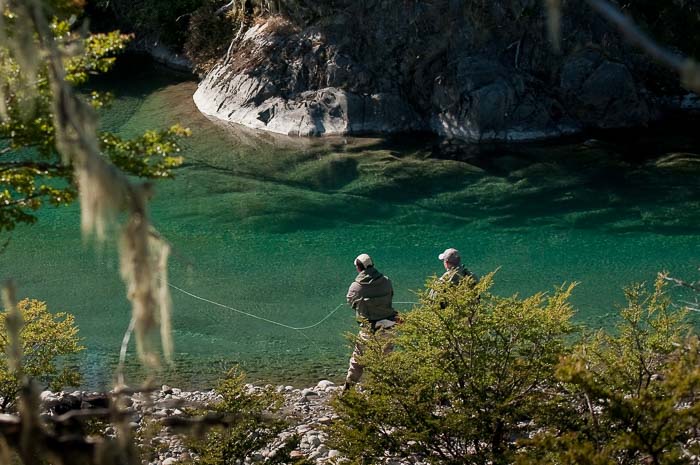
The third leg of our January fishing trip to Patagonia brought us to the legendary Baker River watershed in southern Chilean Patagonia. Our base for the week was to be the Orvis Endorsed Patagonia Baker Lodge. The Baker is Chile’s largest river – a truly massive body of water. The Baker is basically the outlet river of Lago General Carrara which is the largest lake in Patagonia and the second largest in all of South America. The lake spans both Argentina and Chile and is truly enormous. This is rugged country with huge hanging glaciers dripping off of every peak. Most of the Baker on its journey to the ocean becomes silty from glacial flour, but the upper reaches when it exits Lago Bertran (the lake just below General Carrara) have great visibility and are perpetually clear thanks to the large lakes above allowing heavier sediments to settle out. Although the Baker has well over 10 foot clarity it still has just enough glacial flour to give it an unworldly azur blue color. It seems like every photograph of this river has received some heavy photoshop work as a result. The river is truly one of the most beautiful on the planet. Although the Baker is the crown jewel when fishing out of the Patagonia Baker Lodge other fisheries such as Lago Bertran, Lago Carrera, the Corchoran River, the Maiten River and several smaller tributaries help to produce of the most diverse fly fishing in Chile.
The lodge itself is nestled into the dense Lenga tree forest and is perched over the massive river with large decks overlooking perpetually rising rainbows below. Maximum capacity at the lodge is 12 people or 10 anglers.
Day 1: Travelling South from Balmaceda
We had spent the previous week at Magic Waters Patagonia Lodge near Balmaceda. Eduardo gave Randy Buckley, Brett Seng, and Bill Buchbauer a lift to the airport where we met a representative from the lodge who drove us south. The lodge is about 3.5 hours to the south from the airport. The drive is truly spectacular and blends a wide variety of scenery and climate zones. Balmaceda is near the Argentine border in the dryer pampas region. It resembles Dillon, Montana with sweeping vistas and mountains in every direction. As we headed south we soon began gaining elevation as we traversed a large pass. The mountains here were protected by the coastal ranges farther west and had a dryer look and were very similar in look and feel to the Colorado Rockies in the Maroon Bells area. As the drive continued we dropped into the Cerro Castillo Valley with the towering glacier capped peaks looming overhead.
The mountains look a bit like the Tetons but are more expansive and with more glaciers. Eventually we dropped into a heavy rain forest climate zone and passed a series of streams and lakes before dropping down to the shoreline of the massive General Carrera lake – Patagonia’s largest. (called Lago Buenos Aires in Argentina) We skirted the shores of the lake for over an hour before arriving at the lodge. The lodge is tucked into the forest and is perched just over the massive river. Views from the main lodge are stunning with huge picture windows providing a sweeping vista of glaciated peaks and the blue waters of the Baker just below. Our host Manuel Reyes greeted us immediately and showed us to our rooms. Each room had two queen beds with a big picture window overlooking the river. A few of the guides were at the lodge and we walked out to the boat dock to watch the rising trout and listen to their stories of the different fisheries in the region. Our excitement level couldn’t be higher! Dinner was prepared by Sebastian, a young and very talented chef from Santiago. The food was incredible and Manuel gave us a great history of the lodge and the region while we enjoyed our meals and the views out the windows.
Day 2: Baker River streamer fishing
The Baker holds a few massive brown trout that run well into the 30” range with several over the years caught in the 35 and 36” class. These trout aren’t common but they are there and see very few flies. We took advantage of the day of rest our trip south provided and decided to swing for the fence and throw big streamers all day. We walked down to the river from the deck at the lodge where the boats were already waiting at the dock – what a treat! Our guide, Livio, rowed us up a massive eddy and began ferrying us across a large gravel bar – immediately I hooked up on a large 20” hard fighting brown that hammered my olive circus peanut (an articulated streamer pattern). A great start!
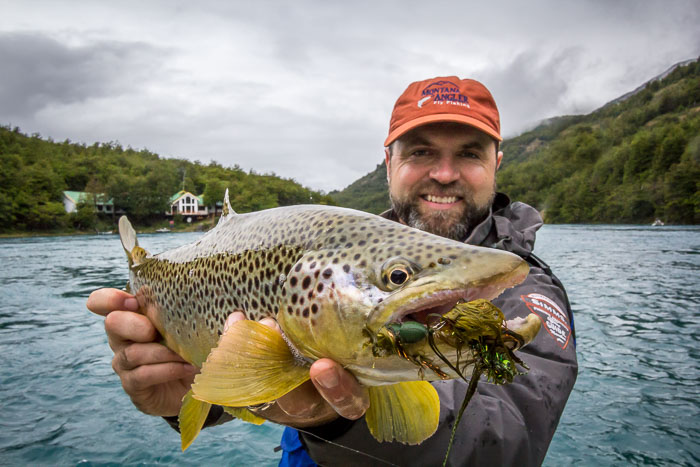 First fish of the week - a nice 20" brown on a streamer 5 minutes into our float with the lodge still in site!
First fish of the week - a nice 20" brown on a streamer 5 minutes into our float with the lodge still in site!Once on the other side Randy set up shop working the bank while Livio and I hiked through the forest to stalk some big browns and rainbows he promised we would find. Just as he suggested we started spotting big fish in the 18-21” range sitting under dense overhangs. Back casts were impossible but I was able to successfully apply a bow and arrow cast to present my streamer to the fish and managed 3 hookups with 2 nice fat rainbows to the net.
The streamer action was truly spectacular. The clear waters allowed us to watch big trout moving from as far as 15 feet to smash the flies. Sometimes the takes were fast and aggressive and other times the fish would slowly follow and finally engage in a soft eat between strips. I stayed with the large circus peanut while Bill and Randy fished smaller sparkle minnows to imitate rainbow trout fry. The bigger articulated fly seemed to be the ticket for browns and I landed about 8 by the end of the day along with another 20 or so rainbows. Bill was in another boat with Brett and it sounds like they had similar action but mostly rainbows. The rainbows in the Baker are all big – mostly between 17 and 20”. The river is so big that the trout spend more time in open water surfing current seams than along bank structures in many areas of the river. January is a high water time for the baker since the wamer summer months produce more glacial melt so the streamer fishing was quite effective. We used 200 grain sinking heads but floating lines would have been just as effective because most of the fish came from below to hit the flies, often just below the surface. I often find a sinking head is more efficient for a long day of streamer fishing even when we are stripping fast and keeping the flies near the surface.
Day 3: Cochoran River
The Cochran has been on my bucket list for years. This river has a reputation for huge trout but also incredibly technical fishing. The river exits and large lake which filters out the sediments to produce crystal clear water. It is a sand bottomed river with a U shaped channel making it nearly impossible to wade – often the water depth drops to 4-6 feet right at the bank. To complicate matters the entire river is lined with willows so the task of getting to the banks is no easy task and many sections of the river are completely unfishable. Site fishing is the method of choice and many anglers opt to use light tippets with heavy nymphs to get down to the fish. Our strategy was going to be a little different. We rigged up a dry rod and a streamer with a heavy sink tip but tippets were heavy – 0X for the streamer and 2X for the dry. We were on a mission not just to hook some huge trout but to also land them and the heavier tippet ensured we would at least stand a chance if we could get a fish to eat. Our guide Carlos took Brett Seng and I on a death march far up river on what he called his “Kung Fu” beat because we would have to fight off the brush and timber. After about an hour of hiking we approached the river. We immediately spotted a 2 foot brown and on the first cast he charged the streamer but refused it. After trying a few other patterns we had one or two casual follows but it didn’t look like we were going to seal the deal and we looked for more fish. We often had to skip 100-200 yards of river at a time to find openings where I could make a cast. Sometimes we spotted trout on the far side of the river just out of casting range. One run had about 10 huge fish sipping dries – all out of range. We spotted another 23” rainbow surfing surface currents in a completely uncatchable location. After a few more follows and chases we realized that hooking these fish was no easy task. Going into lunch we had just one hookup on a smaller brown and nothing to the net. After lunch Brett spotted a massive brown on the other side of the river. We estimated that it was no shorter than 28” and could have very well been an honest 30” trout. The huge fish mesmerized all of us. It was holding in about 6 feet of water but was easily visible while it aggressively fed subsurface over a white sand bottom. The fish was in casting range but a back cast was impossible. I tried moving above the fish to make a long blind cast through brush but we were still about. Carlos and Brett even resorted to climbing trees in an attempt to remove huge branches. It is hard to walk away from such a big fish and after nearly an hour of comically trying to excavate a back cast lane I finally gave up and left Carlos and Brett to their quest to somehow get to the trout. Luckily within 100 yards I spotted another massive brown finning over a weedbed aggressively looking for surface action. It wasn’t quite the 30” leviathan around the bend but it was still one of the biggest browns I have ever cast to. I hollered at the boys and they hustled up and Brett set up with his camera (check out his great imagery at Brett Seng Photography). Since we were using such heavy tippet in what amounted to spring creek conditions my plan was to draw the big fish out of his feeding lane with a shorter cast so he would see the fly first and not the leader. We opted for a medium sized fat albert – a big enough morsel to move a big fish a few feet. The strategy worked and on the first cast the big brown motored about 3 feet out of his lane to inhale the fly. Brett captured the entire sequence with a frame by frame rapid shutter sequence. The water erupted in a giant toilet bowel flush as it rocketed down stream. I had my spring creek 5 weight set up for this fish and a small little click and pall Bozeman Reel SC model. At first I was I regretted not having one of my more traditional style RS series large arbor but the little SC was buttery smooth and was just the ticket. After some aggressive runs and a close call with a weed bed we netted the big brown.
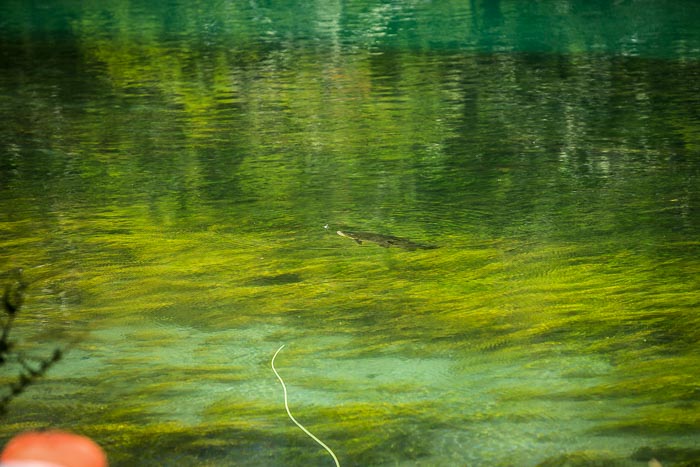 We spotted this 26" brown working the surface over a weed bed. He came to the fat albert on the first cast!
We spotted this 26" brown working the surface over a weed bed. He came to the fat albert on the first cast!
A few runs later we found a nice inside corner run with several rainbows surfing currents. These fish were surface oriented and we were able to pick off about 5 fish all on dries. Each rainbow was about 20” and put up a strong fight in the cold currents. We located a few more big browns in the 22-24” range and had a few follows and short strikes but no more hookups. As the day was growing long we opted for one more stop. There was a deep run and although we didn’t visually locate any big fish I opted to gun a big cast with the streamer just in case. Shooting line on the Cochran is always a challenge since such long casts are required and the running line easily tangles on vegetation. After a few tries I was able to keep the running line out of trouble and gun a cast to the far bank.
There was a nice trough on our side with some brush overhanging so I let the fly sink and swing until it lined up with the sweet spot and then began stripping aggressively. On the 4th strip the line became heavy and a steady rhythmic throbbing sensation telegraphed up the rod – a big brown. The fish was almost immediately down stream and it was all I could do to hold him in position on 0X in strong current. After a few minutes he started moving into the main run and then erupted into a tail walking leap out of the water. The trout was absolutely enormous and Carlos began shouting “30 incher, 30 incher”. My heart was in my throat but I knew I had a good hookset and 0X on my side and so laid everything I had into him to keep the pressure on. Eventually we brought the fish in range – he was so big Carlos had to take three stabs to get him to slide into the net. We taped him at 25” but he was probably a tad longer if laid flat and was much heavier than the other beauty from early in the day in terms of girth. An amazing fish and an amazing day with two of the biggest browns of my life within a few hours of each other.
Day 4: Baker River dry fly and nymph day
The Baker was so impressive on day one we wanted to see it again. Manuel assured us that you can fish the Baker many different ways and we wanted to employ some more traditional tactics to see its other faces. To start the day Livio rowed us up the big home eddy again and out to the giant gravel bar island above the lodge. The “island” was just underwater but we were able to anchor the boat. There was a huge depression where the gravel bar dropped off and Livio and Randy waded along side it with a nymph rig. I set up my camera to enjoy a nice photography session. From my vantage point I could see what must have been at least 40 big rainbows in the 17-20” range surfing back and forth on the gravel drop off.
Randy hit fish after fish – each one running him into his backing. Mixed in with the rainbows was a much larger brown that appeared to be well over 20”. I swam a streamer by him and had a heart stopping follow but couldn’t seal the deal. Randy eventually hooked him but the big brown freight trained down stream and straightened the hook. Since Randy had enough fish in the net by 11am to make it a day we switched out to dries and began hopping from one massive football field sized eddy to the next for the remainder of the day site casting to nice rainbows hugging banks or cruising eddy lines. The weather is incredible with high sun and just a hint of breeze. Another great day on the Baker!
Day 5: Lago Bertran site casting
Day 5 was a travel day for Bill and I as we headed back home. Randy and Brett stayed for the remainder of the week. The high pressure settled in and Randy and Brett headed to Lago Bertran just a few minutes upstream from the lodge. The day proved to be ideal for lake fishing with high sun and zero wind. The lake was like glass and the clear skies and brilliant sunshine made site casting a breeze. Randy reported well over 30 fish – all on big dries caught site fishing. According to Randy every fish was a carbon copy – each a hard fighting 19” rainbow.
Day 6 and 7: small stream tributary fishing
While I was back in Bozeman feverishly trying to catch up – Randy and Brett were still enjoying a few more days at Patagonia Baker Lodge. Randy fished two smaller wade fishing waters near the end of the trip. The Maiten is a small tributary of the Baker where Randy enjoyed fast action dry fly fishing to smaller rainbows in a gorgeous valley. On another day he left with Carlos to explore a new fishery – a small unnamed tributary of Lake General Carrera with similar success.
Trip Summary
All in all our crew was very impressed with both the fishing and the lodge operations out of Patagonia Baker Lodge. The fisheries are very unique and there are very few other operations of quality in this region of Chile resulting in very lightly fished waters. The variety of big river fishing, site casting on lakes, small mountain streams and productive but technical fishing on the Cochran results in a diverse fishing program. Our guides were all outstanding and the size and quality of the trout were truly impressive. This is certainly a location we will be returning to in the future! We are currently scheduling our 2016 hosted trips now so please contact us if you have interest in joining us on our next Patagonian adventure! Part 1 of our January Patagonia Trip Report: Carrileufu River Lodge Argentina Part 2 of our January Patagonia Trip Report: Magic Waters Patagonia Lodge Chile

